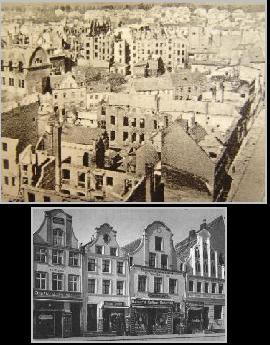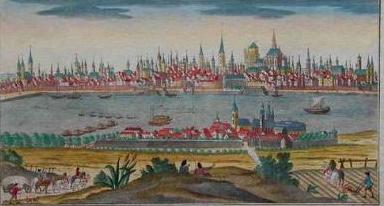

Chemnitz had a pre-World War Two population of 370,000, larger than it has today. On February 15, 1945, Dresden and Chemnitz, both lying in the direct path of the advancing Russian armies, and Magdeburg, about seventy miles south-west of Berlin, were the main targets for devastating blows by over 3,600 planes of the R.A.F and the Eighth US Air Force so as to pave the way for the Red Army. 450 bombers attacked Chemnitz, while 400 went to Magdeberg and 450 to Dresden. The daylight bombing at Chemnitz absolutely devastated the city, destroying it almost completely.
The old St. Wolfgang church in Schneeberg had an altar by Lucas Cranach, with 11 very important scenes, and also a bibliotech with priceless ancient manuscripts, including music scores of the miners’ music. In 1945, low flying American bombers totally destroyed the church and the bibliotech. The altar was taken from the burning building and survived. The city then fell under communist rule and decayed further. In 1953, Chemnitz was renamed Karl-Marx-Stadt, and the city was rebuilt according to Communist principles, with prefab concrete housing blocks and streets adorned with heroic Soviet-style statues, including a huge head of Karl Marx. Very few pre-war buildings were restored. It returned to the original name of Chemnitz in 1990. The city of Chemnitz today is thought to have the lowest birth-rate in the world.
One remaining old landmark is the red tower, built in the late 12th or early 13th century as part of the old city wall. The old Renaissance Rathaus is still standing, as is the smallest castle in Saxony, Rabenstein.


By 1942, the Allies had stopped bombing key military targets in favor of burning the cities and residential districts. Cologne “got what it deserved” on the night of May 30, 1942, when 1,046 RAF aircraft took off from 52 airfields to destroy her. The attack, while hitting only a few factories, managed to cause an enormous loss of life, particularly of women and children.
2,000 tons of high explosive and incendiary bombs dropped on the medieval town until it was engulfed in flame from end to end in 12,000 separate fires. This raid, one of 262 inflicted on the ancient city, lasted about 75 minutes and the fires could be seen 550 miles away. 600 acres of built-up area were destroyed. 90% of the city was utterly destroyed. The Cathedral suffered 14 direct hits but, although badly injured, miraculously remained at least salvageable, and it remains the tallest Gothic structure in the world. The bombs demolished 21 other churches, hundreds of businesses, libraries and schools as well as and nearly 13,000 homes, leaving 45,000-55,000 people homeless. Thousands of people were killed, maimed and burned to death. By the end of the war, the population of Cologne was reduced by 95%.
On February 15, 1945, the lovely old town of Cottbus was bombed by 400 American B-17 bombers dropping 4,000 high-explosive bombs, destroying 356 houses and damaging 3,600. 1,000 people were killed, among them 400 children, and 13,000 were left homeless. Parts of its hospital was destroyed, its doctors and nurses killed. By 1945, only 8,000 out of 50,000 pre-war inhabitants remained alive. 187 people committed suicide. It was handed over to the communists.